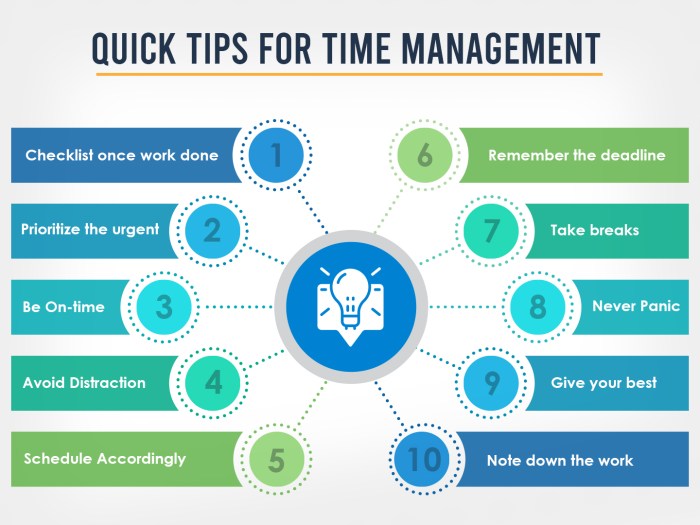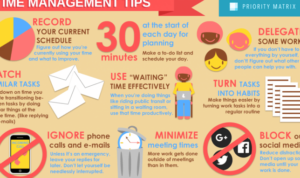Effective Time Management takes center stage in the quest for success, offering a roadmap to juggle personal and professional commitments seamlessly. Get ready to dive into the world of productivity and balance like never before.
In a fast-paced society where time is of the essence, mastering the art of time management is key to unlocking your full potential.
Importance of Effective Time Management
Effective time management is crucial in both personal and professional life as it allows individuals to make the most out of their day, prioritize tasks, and achieve goals efficiently. Poor time management can lead to increased stress levels, missed deadlines, and a feeling of being overwhelmed by the workload.
Benefits of Mastering Time Management Skills
- Increased productivity: By effectively managing time, individuals can focus on important tasks and avoid procrastination, leading to higher productivity levels.
- Improved work-life balance: Proper time management allows individuals to allocate time for work, family, hobbies, and relaxation, leading to a more balanced lifestyle.
- Reduced stress: When tasks are organized and completed on time, individuals experience less stress and anxiety related to deadlines and workload.
Examples of How Effective Time Management Can Improve Productivity
- Setting specific goals and deadlines for each task can help individuals stay focused and motivated to complete them efficiently.
- Using tools like to-do lists, calendars, and time tracking apps can help individuals prioritize tasks and allocate time effectively.
- Implementing the Pomodoro technique, which involves working in focused intervals with short breaks in between, can improve concentration and productivity.
Strategies for Effective Time Management
Effective time management is crucial for high school students to stay organized and on top of their responsibilities. Here are some practical strategies to help you make the most of your time:
Prioritizing Tasks Based on Importance and Urgency
When managing your time, it’s essential to prioritize tasks based on their importance and urgency. One effective method is using the Eisenhower Matrix, which categorizes tasks into four quadrants: urgent and important, important but not urgent, urgent but not important, and neither urgent nor important. By identifying which tasks fall into each category, you can allocate your time and energy accordingly.
- Focus on tasks that are both urgent and important first, as these require immediate attention.
- Next, tackle important but not urgent tasks to prevent them from becoming urgent in the future.
- Delegate or eliminate tasks that are urgent but not important to free up time for more critical responsibilities.
- Lastly, consider whether tasks that are neither urgent nor important are worth your time at all.
Setting Realistic Goals and Deadlines
Setting realistic goals and deadlines is key to effective time management. Break down larger tasks into smaller, more manageable steps with specific deadlines to keep yourself accountable. Use the SMART criteria when setting goals: Specific, Measurable, Achievable, Relevant, and Time-bound. This approach will help you stay focused and motivated as you work towards your objectives.
- Set clear objectives for each task to avoid ambiguity and ensure you know what needs to be accomplished.
- Establish deadlines for each goal to create a sense of urgency and prevent procrastination.
- Review your progress regularly and adjust your goals and deadlines as needed to stay on track.
Creating a Daily or Weekly Schedule, Effective Time Management
Creating a daily or weekly schedule is an effective way to manage your time efficiently. Use a planner or digital calendar to map out your tasks, classes, extracurricular activities, and personal commitments. Block out dedicated time for studying, homework, relaxation, and socializing to maintain a healthy balance in your schedule.
- Allocate specific time slots for each task or activity to ensure you have enough time to complete everything on your to-do list.
- Include buffer time between tasks to account for unexpected delays or additional work that may arise.
- Stick to your schedule as closely as possible, but be flexible and willing to adjust if necessary to accommodate changes or new priorities.
Tools and Apps for Time Management
There are various tools and apps available to help high school students manage their time effectively. Consider using:
- Todoist: A task management app that allows you to create to-do lists, set deadlines, and prioritize tasks.
- Google Calendar: A digital calendar that syncs across devices and lets you schedule events, set reminders, and share calendars with others.
- Pomodoro Technique: A time management method that breaks work into intervals (typically 25 minutes) separated by short breaks to boost productivity.
- Forest: An app that helps you stay focused by planting virtual trees during work sessions and penalizing you for using your phone.
Overcoming Time Management Challenges

In the quest for effective time management, there are several challenges that can hinder productivity and efficiency. It’s crucial to identify these obstacles and develop strategies to overcome them.
Procrastination
Procrastination is a common time management challenge that can derail even the best-laid plans. To overcome procrastination, try breaking tasks into smaller, more manageable steps. Set specific deadlines for each step and hold yourself accountable. Additionally, eliminate distractions and create a conducive work environment to stay focused.
Dealing with Interruptions and Distractions
Interruptions and distractions can disrupt your workflow and impede progress. To combat these challenges, establish boundaries and communicate your availability to others. Set specific times for checking emails and messages, and turn off notifications during focused work sessions. Utilize tools like noise-canceling headphones or designated work areas to minimize distractions.
Handling Unexpected Tasks and Changes in Plans
Unexpected tasks and changes in plans can throw off your schedule and create stress. Develop a flexible mindset and be prepared to adapt to unforeseen circumstances. Prioritize tasks based on urgency and importance, and be willing to delegate or renegotiate deadlines when necessary. Remember to stay organized and maintain a positive attitude in the face of unexpected challenges.
Time Management Techniques for Different Settings

When it comes to managing time effectively, different settings require different strategies. Let’s dive into some techniques for students, workplace professionals, remote workers, and freelancers to make the most out of their time.
Students: Balancing Study, Work, and Personal Life
- Set specific goals for each day to prioritize tasks.
- Use a planner or digital calendar to schedule study time, work hours, and personal activities.
- Avoid multitasking and focus on one task at a time to improve efficiency.
- Take short breaks in between study sessions to stay fresh and focused.
Workplace Professionals: Effective Time Management Tips
- Create a to-do list at the beginning of each day to stay organized.
- Limit distractions by setting designated times to check emails and messages.
- Prioritize tasks based on deadlines and importance to avoid last-minute stress.
- Delegate tasks when necessary to free up time for more critical responsibilities.
Remote Workers and Freelancers: Managing Time Independently
- Establish a designated workspace to separate work from personal life.
- Set specific work hours to create a routine and maintain work-life balance.
- Utilize time-tracking tools to monitor productivity and identify areas for improvement.
- Communicate boundaries with clients and team members to manage expectations effectively.
Prioritizing Tasks with Multiple Projects
- Identify urgent and important tasks using the Eisenhower Matrix.
- Break down larger projects into smaller, manageable tasks to avoid feeling overwhelmed.
- Use a project management tool to track progress and deadlines for each project.
- Regularly reassess priorities and adjust schedules to accommodate shifting project requirements.
